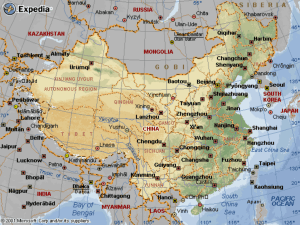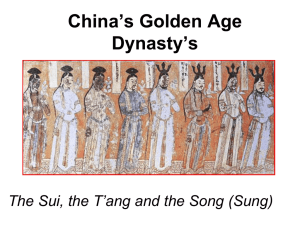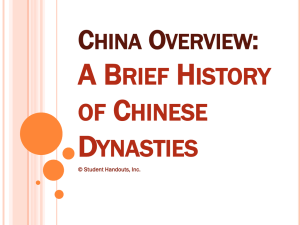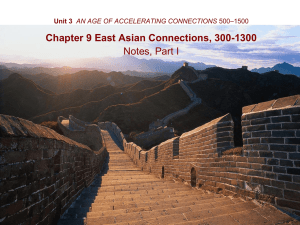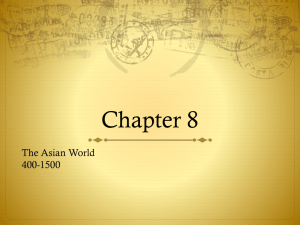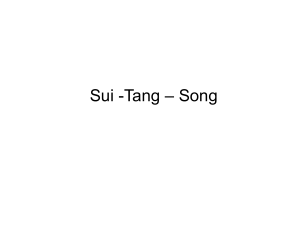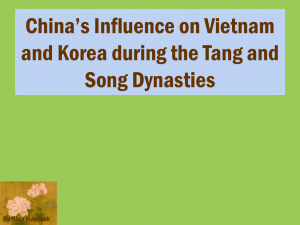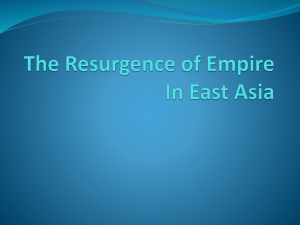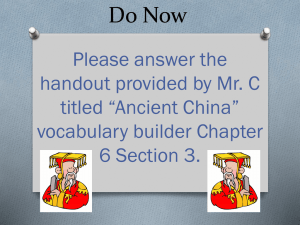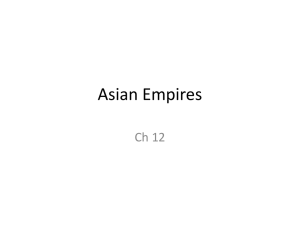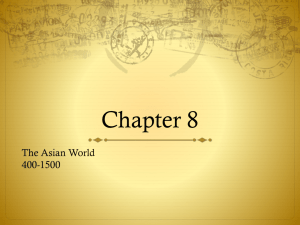China-1
advertisement
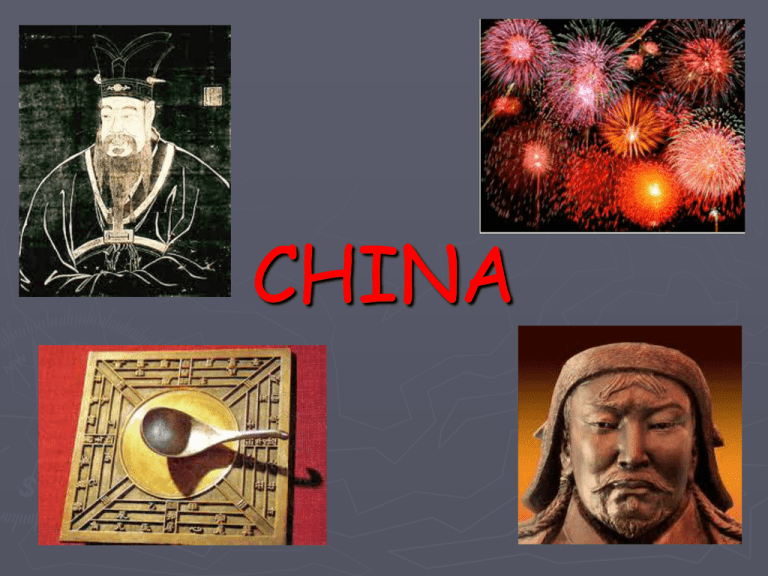
CHINA Geography ► After the Han Dynasty collapsed, China split into several rival kingdoms. This led to: nomadic people settling in Northern China. Because of this settlement, the culture of the nomads and the traditional Chinese mixed. ► Some northern Chinese did not like the nomads and moved south. This led to a blending in the south of northern Chinese and southern Chinese cultures. ► A change in culture – new types of art and music, new foods and clothing styles. ► ► This new blended culture spread over a wider geographic area than ever before, and more people became Chinese. Changes in Agriculture Reasons for Agricultural Changes: ► Movement of farmers to the fertile basins of the Chang Jiang river in southern China (from NORTH TO SOUTH) Attacks by the Mongols drove many landowners from the north to the south. Reasons for Agricultural Changes con’t: ► The move south changed what was grown. It was wetter and warmer RICE ►A new kind of rice is brought to china during the 11th century: Drought resistant Matured in 2 months instead of 5 Reasons for Agricultural Changes con’t: ► New and better farming techniques and tools: Plow and harrow Fertilizer used to produce larger crops Chain pump Terraces ► All AMOUNT OF CROPS GO UP!!!! of these improvements led to increased crop yield. Characteristics of the New Agriculture: ► Terraced hillsides ► Rice paddies where rice is planted by hand ► Rice harvested by hand ► Irrigation – dams, dikes, gated channels and chain pumps ► Also grew tea, cotton and sugar. CHINA DEVELOPS A NEW ECONOMY Results of Agricultural Changes: ► This helped to support a larger population and China’s population grew to more than 100 million people. ► ► Population goes up Food production was increased!! ► ► Peasants could take time away from farming to make silk, cotton, cloth and other products to sell or trade. Farmers could market surplus rice Landowners could buy luxury items All led to the growth of trade and commerce. The Growth of Trade and Commerce Reasons for Growth in Trade and Commerce: Imports – foods, plants, wool, glass, gold, silver ► Exports – teas, rice, spices, jade, silk, porcelain ► Wealthy landowners were eager to buy luxuries ► Water transportation Rivers Grand Canal ► Improvements in navigation Magnetic compass ► Paper money (currency) ► THE GRAND CANAL Characteristics Of China’s Commercial Growth: ► Canals crowded with barges carrying goods ► Peasants come to town to sell their surplus ► Merchants have set up shops ► “Deposit shops” – where copper coins are traded for paper money Paper money has no value itself. If there is too much in circulation it loses its value. Results of Growth in Trade and Commerce: ► Resulted in the growth of the merchant class ► Business activity brought increased prosperity – giving China the highest standard of living ► Commercial centers grew into big cities URBANIZATION Urbanization Reasons for the growth of cities: ► The growth of commerce encouraged people to move to cities and towns ► Wealthy landowners left their farms because they liked the shops and social life of the cities. Chang’an was China’s capital during the Tang Dynasty and was a trade center. ► It was the largest city in the world at that time. Characteristics of Cities: ► Crowded and exciting ► Streets filled with shops, merchants, moneylenders, and traders ► Entertainment Musicians Jugglers Acrobats Puppeteers ► Theaters, restaurants, teahouses ► Food vendors Results of Urbanization: ► Changed the way ordinary Chinese lived ► Public works projects employed many city dwellers ► Stimulated Art culture The Political Development of Imperial China Imperial China ► Historians divide Chinese history into periods ruled by dynasties Dynasties are ruling families ► Mandate of Heaven Chinese believed that Heaven supported the dynasty for as long as the emperor ruled well. Natural disasters were taken as signs that Heaven was displeased. Qin Dynasty ► 221-206 B.C.E. ► Known for unification of China under an emperor The Legalists strengthened state power and control over the people. The Chinese writing system were unified. Chinese defenses were strengthened by creating the Great Wall. ► ► ► Han Dynasty ► 206 B.C.E. – 220 C.E. ► Known as a golden age and a united China Fall of the Han Dynasty ► Corrupt control relatives of the emperor seized High taxes ruined families Workers were forced to labor on public projects Bandits attacked the countryside The government could not protect the farmers. The farmers rebelled The Han dynasty lost the Mandate of Heaven Period of Disunion ► 220 – 589 ► This is the period of time following the fall of the Han Dynasty. China was split into several rival kingdoms each ruled by military leaders. ► ► Because of this disunion and the movement of people throughout China, a cultural blending took place. Sui (Sway) Dynasty ► ► ► ► 589-618 C.E. Period of Disunion ends in 589 Yang Jian (Yang Jee-en) conquered the south and unified China. Yang Jian later named Wen Di which means “civic” or “polished” emperor Sui Dynasty ► • • • • Actions: Started the Grand Canal which links northern and southern China. Made improvements to the Great Wall Wen Di was Buddhist, but he supported Buddhism, Confucianism, and Daoism in order to unite people. Civic projects helped unite people. • However, Wen Di and his son were harsh and forced peasants who could not pay taxes to fight in the army or work on civic projects – one project was to increase the size of the palace. However over 1 million workers were needed and 40% died on the project! The Tang Dynasty The Tang Dynasty 618-907 C.E. Known for economic development and growth – many inventions and discoveries The Tang Dynasty ► ► ► ► Sui official overthrew the government and started the Tang Dynasty. Expanded China’s land Considered the golden age of China for art and culture. Empress Wu China’s only woman ruler – her husband was sick and eventually died – she decided her sons were not worthy to rule. She ruled with an “iron fist” - if people opposed her then they faced death She chose advisors based on ability rather than their rank! Aristocracy Relied on a large bureaucracy – so big government had the power and not the locals Used civil service exams to fill some positions CHOSE ARISTOCRATS FOR MOST HIGH-LEVEL JOBS. Calligraphy Tang Dynasty Poem Divinity: Buddha from Tang Dynasty Tang Dynasty Bronze Dragon The Song Dynasty The Song Dynasty 960-1279 C.E. – reunified China again after 50 years of civil war Known for economic development and growth; many inventions and discoveries Meritocracy MEANS RULE BY OFFICIAL CHOSEN FOR THEIR MERIT. The Song relied on civil service exams and opened them up to more candidates. People from LOWER CLASSES gained the ability to become scholar-officials Gate Scene – Song Dynasty Mongol Empire Yuan Dynasty 1279-1368 C.E. Control of China by foreigners Mongol Invasion ► Led by Genghis Khan in 1206 ► Brutal ► Ruled ruler (killed men, women, children) most of Asia, and then conquered northern China by his death in 1227 Kublai Khan ► Grandson Kublai Khan takes over after 40 years of fighting (only non-Chinese Dynasty) *PG. 187 (Yuan Dynasty 12601368)* ► Completes Chinese conquest ► Emperor in 1279 ► Seen as rude and uncivilized (different language, customs, gods) Kublai Kahn Life under Yuan ► Khan did not force ideas on Chinese, but did force high taxes (public works projects completed by Chinese workers) ► Social Classes were very important: ► 1st class: tax-free Mongols ► 2nd class: non-Chinese civil servants ► 3rd class: Northern Chinese ► 4th class: Southern Chinese Life under Yuan ► Khan believed in traditional shamanism (good and evil spirits heard through priests), but allowed Chinese people to keep their beliefs ► Marco Polo (Italian trader who served on Khan’s court and wrote about Khan’s trade) ► Invaded Japan 1274 and 1281-weather caused failure…remember this for Japan! ► Mongols were weak (battles destroyed farmland and people) and Chinese rebelled and regained control in 1300s Society and Culture ► Society and culture varied by dynasty Men were in power except for Empress Wu There was a focus on agriculture and trade Social conventions – foot binding Foot Binding ► Began late in the Tang Dynasty and continued for the next thousand years. ► An attempt to stop the growth of the feet. ► Began somewhere between the ages of four and seven. "If you love your daughter, bind her feet; if you love your son, let him study," or so goes the old Chinese saying. Foot Binding Arts and Inventions ► Most advancements under the Tang and Song dynasties ► Art Painted murals that celebrated Buddhism and nature Poems Made clay sculptures Made porcelain items covered in a pale green glaze - celadon Arts and Inventions ► Some of the most important in human history under the Tang and Song. Paper Porcelain Woodblock printing Gunpowder Movable type Magnetic compass Paper money
